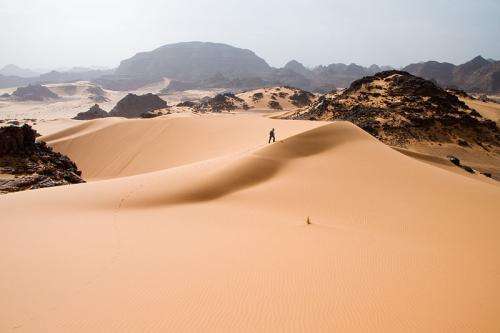September 18, 2014 report
Computer simulations suggest aridification of Sahara occurred longer ago than thought

(Phys.org) —A team of researchers with members from China, Norway and France has built a computer simulation that shows that the Sahara desert came about far earlier than conventional thinking suggests. In their paper published in the journal Nature, the team explains how they gathered data from several sources to create their simulation and why it shows an older Sahara.
Most planetary scientists believe that the Sahara desert came to exist sometime between two and three million years ago (during the most recent glaciation cycling)—geological data has supported this notion. Recently, however, studies of dune deposits have suggested the area became drier farther back in time than that. The problem was, there wasn't a smoking gun that might explain the relatively sudden changes in rainfall. Intrigued by the seeming conundrum, the researchers with this new effort, sought to build a computer simulation that might shed more light on the history of Northern Africa and the conditions that led to the creation of the largest (non-polar) desert in the world.
To create their simulation, the researchers input data that described the geology of the area over the past 30 millions of years, including tectonic plate shifting. They also input atmospheric conditions and changes in the Earth's orbital position over the same time-span.
In running the simulation, the researchers watched as what was once the Tethys Sea—a massive body of water that separated the supercontinents—was largely drained when the African plate collided with the Eurasian plate, giving rise to the Himalayas and Alps and leaving behind the Mediterranean, Caspian and Black Seas and a suddenly exposed Arabian Peninsula. That left less reflective surface area in the region, the simulation showed, which led to less rainfall (approximately half as much) over North Africa. Less rainfall during subsequent times of changes to Earth's tilt, led eventually to desertification—all approximately 7 million years ago.
More research will have to be done of course, but if the simulation is eventually excepted as depicting the actual history of the area, that could have major implications for scientists who study human ancestry—our forbearers are believed to have got their start, after all, just south of the area in question.
More information: Aridification of the Sahara desert caused by Tethys Sea shrinkage during the Late Miocene, Nature 513, 401–404 (18 September 2014) DOI: 10.1038/nature13705
Abstract
It is widely believed that the Sahara desert is no more than ~2–3 million years (Myr) old1, with geological evidence showing a remarkable aridification of north Africa at the onset of the Quaternary ice ages2, 3, 4. Before that time, north African aridity was mainly controlled by the African summer monsoon (ASM), which oscillated with Earth's orbital precession cycles. Afterwards, the Northern Hemisphere glaciation added an ice volume forcing on the ASM, which additionally oscillated with glacial–interglacial cycles2. These findings led to the idea that the Sahara desert came into existence when the Northern Hemisphere glaciated ~2–3 Myr ago. The later discovery, however, of aeolian dune deposits ~7 Myr old suggested a much older age, although this interpretation is hotly challenged1 and there is no clear mechanism for aridification around this time. Here we use climate model simulations to identify the Tortonian stage (~7–11 Myr ago) of the Late Miocene epoch as the pivotal period for triggering north African aridity and creating the Sahara desert. Through a set of experiments with the Norwegian Earth System Model and the Community Atmosphere Model, we demonstrate that the African summer monsoon was drastically weakened by the Tethys Sea shrinkage during the Tortonian, allowing arid, desert conditions to expand across north Africa. Not only did the Tethys shrinkage alter the mean climate of the region, it also enhanced the sensitivity of the African monsoon to orbital forcing, which subsequently became the major driver of Sahara extent fluctuations. These important climatic changes probably caused the shifts in Asian and African flora and fauna observed during the same period, with possible links to the emergence of early hominins in north Africa.
Journal information: Nature
© 2014 Phys.org





















